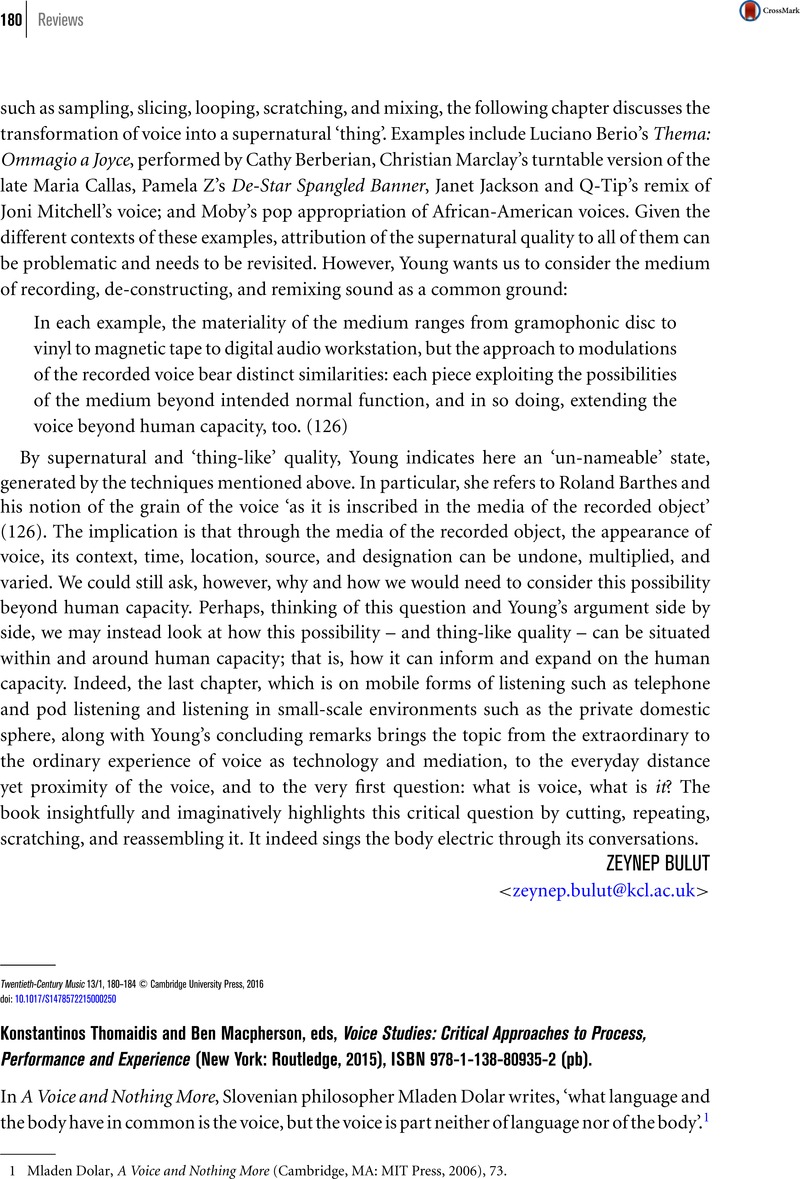No CrossRef data available.
Article contents
Konstantinos Thomaidis and Ben Macpherson, eds, Voice Studies: Critical Approaches to Process, Performance and Experience (New York: Routledge, 2015), ISBN 978-1-138-80935-2 (pb).
Published online by Cambridge University Press: 14 March 2016
Abstract

- Type
- Reviews
- Information
- Copyright
- Copyright © Cambridge University Press, 2016
References
1 Dolar, Mladen, A Voice and Nothing More (Cambridge, MA: MIT Press, 2006), 73Google Scholar.
2 Cavarero, Adriana, For More than One Voice: Toward a Philosophy of Vocal Expression, trans. Paul A. Kottman (Stanford, CA: Stanford University Press, 2005), 177–8Google Scholar.
3 Connor, Steven, Dumbstruck: A Cultural History of Ventriloquism (Oxford and New York: Oxford University Press, 2000)CrossRefGoogle Scholar.
4 Ihde, Don, Listening and Voice: Phenomenologies of Sound (Albany, NY: State University of New York Press, 2007)Google Scholar.
5 Chion, Michel, The Voice in Cinema, ed. and trans. Gorbman, Claudia (New York: Columbia University Press, 1999)Google Scholar.
6 Merleau-Ponty, Maurice, Phenomenology of Perception (New York: Routledge, 1962)Google Scholar.
7 Linklater, Kristin, Freeing the Natural Voice (New York: Drama Books, 1976)Google Scholar. For a productive look at clean and dirty vocality in Christian singing communities of South Korea, see also Harkness, Nicholas, Songs of Seoul: An Ethnography of Voice and Voicing in Christian South Korea (Berkeley and Los Angeles: University of California Press, 2014)Google Scholar.
8 For an expansion on these ideas, see Eidsheim's Sensing Sound: Singing and Listening as Vibrational Practice (Durham, NC: Duke University Press, 2015).
9 Music, Words and Voice: A Reader, ed. Martin Clayton (Manchester and New York: Manchester University Press, 2008).
10 Neumark, Norie, Gibson, Ross, and van Leeuwen, Theo, VOICE: Vocal Aesthetics in Digital Arts and Media (Cambridge, MA: MIT Press, 2010)CrossRefGoogle Scholar.
11 See, for example, the Oxford Handbook of Voice Studies (ed. Nina Eidsheim and Ketherine Meizel, forthcoming on Oxford University Press). Also Neumark, Norie, Gibson, Ross, and van Leeuwen, Theo, VOICE: Vocal Aesthetics in Digital Arts and Media (Cambridge, Mass.: MIT Press, 2010)CrossRefGoogle Scholar.
12 In particular, through events such as the ‘Giving Voice’ Conference, which I first attended in 2006 at Aberystwyth University in Wales, discussed by Lyn Darnley in the concluding chapter.
13 Examples outside of this volume include Calame-Griaule, Geneviève, ‘Voice and the Dogon World’, Notebooks in Cultural Analysis, A Special Issue on ‘Voice’, 3 (1986), 15–60Google Scholar. See also Gautier, Ana María Ochoa, Aurality: Listening and Knowledge in Nineteenth-Century Colombia (Durham, NC: Duke University Press, 2014)Google Scholar.
14 A notable exception here is Kjeldsen's chapter, which draws on voice anatomy and physiology in order to discuss freedom and control in the singing voice.
15 For example, critical engagement with scholars featured in recent works such as Kreimen, Jody and Sidtis, Diana, Foundations of Voice Studies (Malden, MA: Wiley-Blackwell, 2011)CrossRefGoogle Scholar, Sterne, Jonathan, Sound Studies Reader (New York: Routledge, 2014)Google Scholar, which includes a section on voice, or with Novak, David, Keywords in Sound (Durham, NC: Duke University Press, 2015)CrossRefGoogle Scholar would have made the collection stronger.


